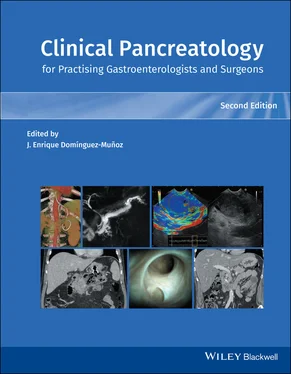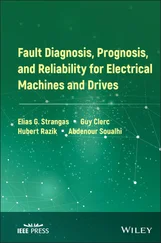Earlier studies had shown a high prevalence of microlithiasis in patients with idiopathic AP; however, recent studies have shown a much lower prevalence ( Table 2.2). One of the reasons could have been the reliance in earlier studies on duodenal bile microscopy to detect biliary crystals, an indirect method, in order to diagnose microlithiasis. This has largely been supplanted by EUS which detects microliths directly. Microlithiasis should be considered as a cause of pancreatitis in the presence of abnormal liver function tests within the first 24–48 hours of onset of AP as mentioned above in the context of gallstones [36].
Once a patient develops gallstone pancreatitis, cholecystectomy should be advised. Endoscopic sphincterotomy alone might prevent the recurrence by not allowing the small stone to obstruct the papilla of Vater. In a study of 5079 patients, recurrence of biliary AP in those treated with endoscopic sphincterotomy occurred in 6.7%; cholecystectomy was able to reduce this rate to 4.4%, while cholecystectomy followed by endoscopic sphincterotomy further reduced the rate to 1.2% [37].
Table 2.2 Frequency of biliary microlithiasis in recurrent acute pancreatitis.
| Study |
Frequency of microlithiasis |
| Older studies |
| Ros et al. 1991 [29] |
37/51 (73%) |
| Lee et al. 1992 [30] |
21/29 (72%) |
| Sherman et al. 1993 [31] |
7/13 (54%) |
| Kaw et al. 1996 [32] |
15/25 (60%) |
| Newer studies |
| Garg et al. 2007 [33] |
10/75 (13%) |
| Wilcox et al. 2016 [34] |
20/200 (10%) |
In 1878, Cawley [38] first described the association by using the term “drunkard pancreatitis.” A case–control study from Japan showed that the odds ratio for development of pancreatitis increased after consumption of more than 20 g/day of alcohol. With subsequent incremental dose of alcohol intake, the odds ratio increased further to 6.4 with an alcohol consumption of more than 100 g/day [39]. A recent meta‐analysis and systematic review demonstrated a dose–response relationship between alcohol consumption and the risk of development of pancreatitis (both acute and chronic pancreatitis). Despite this evidence, alcoholic pancreatitis occurs in less than 10% of heavy drinkers [40]. The drinking pattern and lifetime alcohol intake are similar in patients with alcoholic pancreatitis and asymptomatic heavy drinkers [41]. These observations suggest that there are other factors which either make the pancreas susceptible (e.g. genetic predisposition) or act as a cofactor (e.g. tobacco use) [40,42].
Drug‐induced Pancreatitis
Making an etiological diagnosis of drug‐induced pancreatitis is difficult as it is a rare entity and other causes of pancreatitis should be ruled out before making the diagnosis. The duration between the exposure and the onset of pancreatitis is variable, suggesting idiosyncratic reaction in a majority of cases [43]. The diagnosis of drug‐induced pancreatitis should be considered in the presence of a temporal relationship with the offending drug (see Table 2.1), normal calcium and triglyceride levels, and in the absence of common etiologies (e.g. gallstone, alcohol abuse).
Other Etiological Diagnoses of Acute Pancreatitis
Hypercalcemia
This is an uncommon but treatable cause of AP. Hypercalcemia must be ruled out initially and again after recovery from AP as calcium levels may be lower during an acute attack of pancreatitis. The most common cause of hypercalcemia is hyperparathyroidism. Many patients may have an elevated level of parathyroid hormone but vitamin D deficiency should be excluded before diagnosing hyperparathyroidism.
Hypertriglyceridemia (HTG) is another uncommon but important metabolic cause of AP. Serum triglyceride levels above 1000 mg/dl can cause pancreatitis. Even lower levels may be associated with a higher risk of AP. The mechanism of pancreatitis due to HTG is not fully understood. Most patients with severe HTG have an underlying familial disorder of lipid metabolism, which needs further evaluation. Since only some patients with HTG develop AP, a cofactor may be required to cause pancreatitis. A higher frequency of CFTR mutations has been reported in HTG‐induced pancreatitis [44]. In alcoholic pancreatitis, serum triglyceride level can be elevated during an acute episode. Insulin with heparin and plasmapheresis have been shown to be beneficial in lowering lipid levels and improving the course of pancreatitis [45,46]. A newer therapy has been introduced in the form of an antisense molecule known as volanesorsen [47].
Smoking increases the risk of AP. A Swedish population‐based study showed that the risk of non‐gallstone‐related pancreatitis was more than double in current smokers with more than 20 pack‐years than lifelong nonsmokers [relative risk 2.29, 95% confidence interval (CI) 1.63–3.22]. Among alcoholics consuming more than 400 g/month of alcohol, the risk of developing pancreatitis was fourfold higher in smokers than in lifelong nonsmokers [48]. Former smokers were also at increased risk of AP as shown in a meta‐analysis [49]. The risk of AP decreased to normal (similar to the nonsmoking population) after at least two decades of smoking cessation [48].
In a retrospective cohort study, patients with type 2 diabetes had a 2.83‐fold (95% CI 2.61–3.06) increased risk of AP and a 1.91‐fold (95% CI 1.84–1.99) greater risk of biliary disease [50]. This finding has been confirmed in other studies [51,52]. Patients taking antidiabetic drugs have a reduced risk of AP and the adjusted hazard ratio decreases to 0.31 from 1.89 [53].
Pancreatobiliary tumors are an uncommon etiology but should be considered in patients older than 50 years who present with no identifiable cause of AP. Both benign and malignant lesions, such as periampullary tumor, pancreatic adenocarcinoma, neuroendocrine tumor, and intraductal pancreatic mucinous neoplasm, can present with pancreatitis in 2–7% of patients [54]. These tumors can be diagnosed by CT, magnetic resonance imaging (MRI) and/or EUS. For small tumors, EUS is better than cross‐sectional imaging [55].
AP is the most common complication of ERCP. Transient hyperamylasemia occurs in up to 75% of patients after ERCP without abdominal pain. Hence, AP should be considered in patients with clinical evidence of pancreatitis in the presence of elevated (at least three times the upper limit of normal) serum amylase/lipase level at 24 hours post ERCP and requiring admission or prolongation of planned admission to two to three days [56]. Based on this definition, the incidence of post‐ERCP pancreatitis is 3–10% in systematic reviews [57–59]. A four‐ or six‐hour amylase/lipase level of more than four to five times the upper limit of normal can also predict post‐ERCP pancreatitis with high sensitivity and specificity [60]. Perforation is an important differential diagnosis and there should be a low threshold to perform abdominal CT with oral contrast if there is a suspicion of perforation as a differential diagnosis as it is the most sensitive and specific test [61,62].
Independent patient‐ and procedure‐related risk factors act synergistically in post‐ERCP pancreatitis ( Table 2.3).
Single and Double Balloon Enteroscopy
Single‐ and double‐balloon enteroscopy may cause hyperamylasemia in 16–17% of patients and may be due to stretch and friction of proximal intestine. However, clinical AP occurs in a small fraction (0.7%) of patients who undergo balloon enteroscopy [64,65].
Читать дальше












